1. Torre LA, Siegel RL, Ward EM, Jemal A. Global cancer incidence and mortality rates and trends--An update. Cancer Epidemiol Biomarkers Prev. 2016; 25(1):16–27. PMID:
26667886.

2. Varghese C, Carlos MC, Shin HR. Cancer burden and control in the Western Pacific region: challenges and opportunities. Ann Glob Health. 2014; 80(5):358–369. PMID:
25512151.
3. Jung KW, Won YJ, Kong HJ, Lee ES. Cancer statistics in Korea: incidence, mortality, survival, and prevalence in 2016. Cancer Res Treat. 2019; 51(2):417–430. PMID:
30913865.

4. Ferlay J, Colombet M, Soerjomataram I, Dyba T, Randi G, Bettio M, et al. Cancer incidence and mortality patterns in Europe: estimates for 40 countries and 25 major cancers in 2018. Eur J Cancer. 2018; 103:356–387. PMID:
30100160.

5. Bray F, Ferlay J, Soerjomataram I, Siegel RL, Torre LA, Jemal A. Global cancer statistics 2018: GLOBOCAN estimates of incidence and mortality worldwide for 36 cancers in 185 countries. CA Cancer J Clin. 2018; 68(6):394–424. PMID:
30207593.

6. Lievens Y, Dunscombe P, Defourny N, Gasparotto C, Borras JM, Grau C. HERO (Health Economics in Radiation Oncology): a pan-European project on radiotherapy resources and needs. Clin Oncol (R Coll Radiol). 2015; 27(2):115–124. PMID:
25467072.

7. Hanna TP, Shafiq J, Delaney GP, Vinod SK, Thompson SR, Barton MB. The population benefit of evidence-based radiotherapy: 5-year local control and overall survival benefits. Radiother Oncol. 2018; 126(2):191–197. PMID:
29229506.

8. Slotman BJ, Cottier B, Bentzen SM, Heeren G, Lievens Y, van den Bogaert W. Overview of national guidelines for infrastructure and staffing of radiotherapy. ESTRO-QUARTS: work package 1. Radiother Oncol. 2005; 75(3):349–354. PMID:
15893832.

9. Citrin DE. Recent developments in radiotherapy. N Engl J Med. 2017; 377(11):1065–1075. PMID:
28902591.

10. Zietman A. The future of radiation oncology: the evolution, diversification, and survival of the specialty. Semin Radiat Oncol. 2008; 18(3):207–213. PMID:
18513631.

11. Kwon S. Thirty years of national health insurance in South Korea: lessons for achieving universal health care coverage. Health Policy Plan. 2009; 24(1):63–71. PMID:
19004861.

12. Jung KW, Park S, Kong HJ, Won YJ, Lee JY, Park EC, et al. Cancer statistics in Korea: incidence, mortality, survival, and prevalence in 2008. Cancer Res Treat. 2011; 43(1):1–11. PMID:
21509157.

13. Rim CH, Lee J, Kim WC, Yang D, Yoon WS, Koom WS, et al. A survey of radiation therapy utilization in Korea from 2010 to 2016: focusing on use of intensity-modulated radiation therapy. J Korean Med Sci. 2018; 33(9):e67. PMID:
29441739.

14. Smith BD, Haffty BG, Wilson LD, Smith GL, Patel AN, Buchholz TA. The future of radiation oncology in the United States from 2010 to 2020: Will supply keep pace with demand? J Clin Oncol. 2010; 28(35):5160–5165. PMID:
20956628.

15. International Agency for Research on Cancer. Global cancer observatory. Updated 2020. Accessed December 9, 2020.
https://gco.iarc.fr.
16. Hong S, Won YJ, Park YR, Jung KW, Kong HJ, Lee ES, et al. Cancer statistics in Korea: incidence, mortality, survival, and prevalence in 2017. Cancer Res Treat. 2020; 52(2):335–350. PMID:
32178489.

17. Kim E, Jang WI, Kim MS, Paik EK, Kim HJ, Yoo HJ, et al. Clinical utilization of radiation therapy in Korea, 2016. J Radiat Res. 2020; 61(2):249–256. PMID:
31913473.

18. Nutting C, Dearnaley DP, Webb S. Intensity modulated radiation therapy: a clinical review. Br J Radiol. 2000; 73(869):459–469. PMID:
10884741.

19. Schumacher LD, Dal Pra A, Hoffe SE, Mellon EA. Toxicity reduction required for MRI-guided radiotherapy to be cost-effective in the treatment of localized prostate cancer. Br J Radiol. 2020; 93(1114):20200028. PMID:
32783629.

20. Ge Y, Wu QJ. Knowledge-based planning for intensity-modulated radiation therapy: a review of data-driven approaches. Med Phys. 2019; 46(6):2760–2775. PMID:
30963580.

21. Benedict SH, Yenice KM, Followill D, Galvin JM, Hinson W, Kavanagh B, et al. Stereotactic body radiation therapy: the report of AAPM Task Group 101. Med Phys. 2010; 37(8):4078–4101. PMID:
20879569.

22. Ma L, Wang L, Tseng CL, Sahgal A. Emerging technologies in stereotactic body radiotherapy. Chin Clin Oncol. 2017; 6(Suppl 2):S12. PMID:
28917250.

23. Arbea L, Ramos LI, Martínez-Monge R, Moreno M, Aristu J. Intensity-modulated radiation therapy (IMRT) vs. 3D conformal radiotherapy (3DCRT) in locally advanced rectal cancer (LARC): dosimetric comparison and clinical implications. Radiat Oncol. 2010; 5(1):17. PMID:
20187944.

24. Paumier A, Le Péchoux C, Beaudré A, Negretti L, Ferreira I, Roberti E, et al. IMRT or conformal radiotherapy for adjuvant treatment of retroperitoneal sarcoma? Radiother Oncol. 2011; 99(1):73–78. PMID:
21439664.

25. Kucha N, Soni TP, Jakhotia N, Patni N, Singh DK, Gupta AK, et al. A prospective, comparative analysis of acute toxicity profile between three-dimensional conformal radiotherapy (3DCRT) and intensity-modulated radiotherapy (IMRT) in locally advanced head and neck cancer patients. Cancer Treat Res Commun. 2020; 25:100223. PMID:
33120316.

26. The Korean Health and Insurance Review and Assessment Service. Healthcare Bigdata Hub. Updated 2020. Accessed December 9, 2020.
http://opendata.hira.or.kr.
27. Xu D, Li G, Li H, Jia F. Comparison of IMRT versus 3D-CRT in the treatment of esophagus cancer: a systematic review and meta-analysis. Medicine (Baltimore). 2017; 96(31):e7685. PMID:
28767597.
28. Ursino S, D'Angelo E, Mazzola R, Merlotti A, Morganti R, Cristaudo A, et al. A comparison of swallowing dysfunction after three-dimensional conformal and intensity-modulated radiotherapy: a systematic review by the Italian Head and Neck Radiotherapy Study Group. Strahlenther Onkol. 2017; 193(11):877–889. PMID:
28616822.
29. Lee J, Shin IS, Kim WC, Yoon WS, Koom WS, Rim CH. Reirradiation with intensity-modulated radiation therapy for recurrent or secondary head and neck cancer: meta-analysis and systematic review. Head Neck. 2020; 42(9):2473–2485. PMID:
32437021.

30. Mell LK, Mehrotra AK, Mundt AJ. Intensity-modulated radiation therapy use in the U.S., 2004. Cancer. 2005; 104(6):1296–1303. PMID:
16078260.

31. Mayles WP. Radiotherapy Development Board. Survey of the availability and use of advanced radiotherapy technology in the UK. Clin Oncol (R Coll Radiol). 2010; 22(8):636–642. PMID:
20667700.

32. Redmond KJ, Lo SS, Soltys SG, Yamada Y, Barani IJ, Brown PD, et al. Consensus guidelines for postoperative stereotactic body radiation therapy for spinal metastases: results of an international survey. J Neurosurg Spine. 2017; 26(3):299–306. PMID:
27834628.

33. Sahgal A, Roberge D, Schellenberg D, Purdie TG, Swaminath A, Pantarotto J, et al. The Canadian Association of Radiation Oncology scope of practice guidelines for lung, liver and spine stereotactic body radiotherapy. Clin Oncol (R Coll Radiol). 2012; 24(9):629–639. PMID:
22633542.
34. Low DA, Moran JM, Dempsey JF, Dong L, Oldham M. Dosimetry tools and techniques for IMRT. Med Phys. 2011; 38(3):1313–1338. PMID:
21520843.

35. Zhang S, Yang R, Shi C, Li J, Zhuang H, Tian S, et al. Noncoplanar VMAT for brain metastases: a plan quality and delivery efficiency comparison with coplanar VMAT, IMRT, and CyberKnife. Technol Cancer Res Treat. 2019; 18:1533033819871621. PMID:
31451059.

36. Tsai JS, Micaily B, Miyamoto C. Optimization and quality assurance of an image-guided radiation therapy system for intensity-modulated radiation therapy radiotherapy. Med Dosim. 2012; 37(3):321–333. PMID:
22417899.

37. Huh SJ. Korean Society of Therapeutic Radiology and Oncology (KOSTRO). Current status of the infrastructure and characteristics of radiation oncology in Korea. Jpn J Clin Oncol. 2007; 37(8):623–627. PMID:
17673472.

38. Atun R, Jaffray DA, Barton MB, Bray F, Baumann M, Vikram B, et al. Expanding global access to radiotherapy. Lancet Oncol. 2015; 16(10):1153–1186. PMID:
26419354.

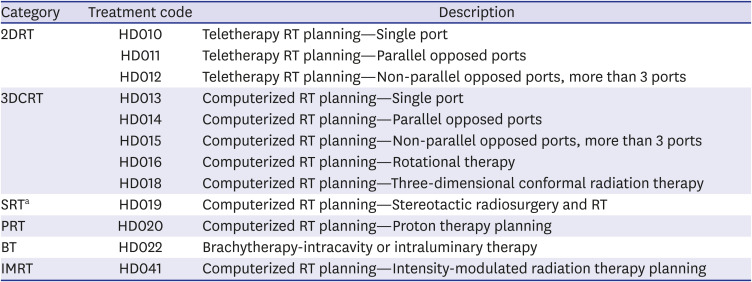

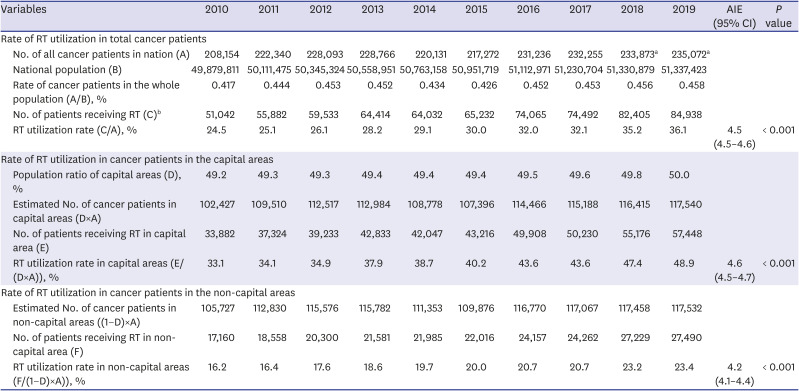
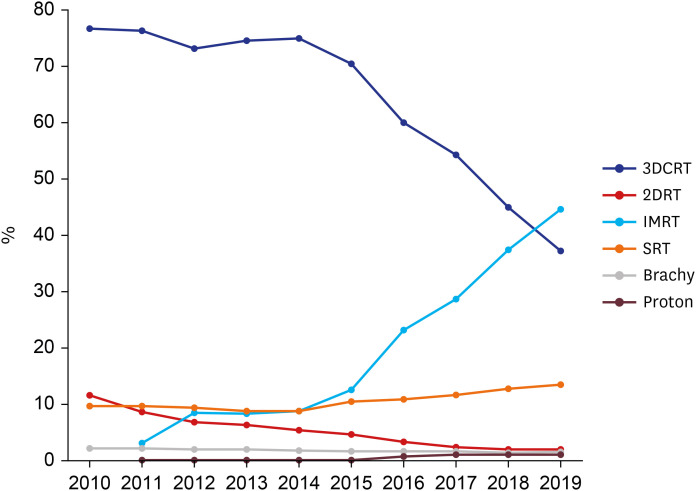
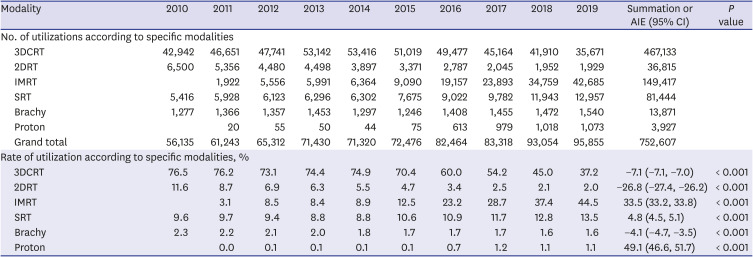

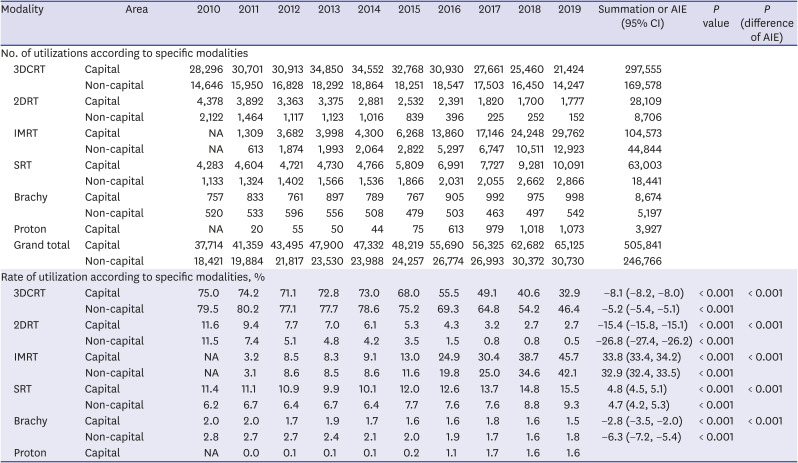




 PDF
PDF Citation
Citation Print
Print



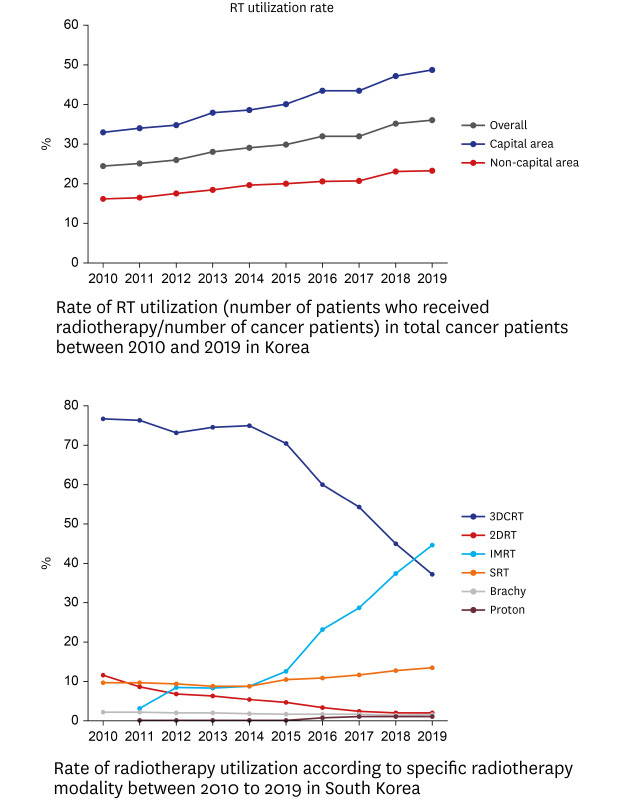
 XML Download
XML Download